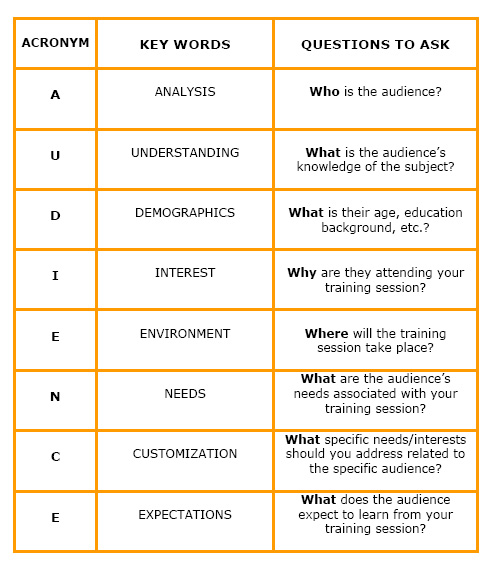Difference between revisions of "Audience Analysis"
From Learning and training wiki
| Line 25: | Line 25: | ||
[[Image:word.png]] [[Media:Audience_Analysis_Template.doc|Audience Analysis Template]] | [[Image:word.png]] [[Media:Audience_Analysis_Template.doc|Audience Analysis Template]] | ||
| − | |||
| − | |||
| − | |||
| − | |||
| − | |||
| − | |||
| − | |||
| − | |||
| − | |||
| − | |||
| − | |||
| − | |||
| − | |||
| − | |||
| − | |||
| − | |||
| − | |||
| − | |||
| − | |||
== References == | == References == | ||
<references/> | <references/> | ||
Revision as of 18:47, 2 November 2011
| A task or a tool which is generally the first step in setting a training activity. Training activities are targeted toward an intended audience, which should be defined by a number of factors such as learner's personal characteristics, intellectual and technology skills, knowledge level and purpose of learning. Conducting an audience analysis helps to identify the profile of the intended audience, facilitating the design of the learning strategy that best suits its needs. [1] |
GuidelinesConducting an audience analysis requires the identification of specific characteristics related to demographics, interests, knowledge, learning needs, and learning expectations - the who, what, where and why one can find in the audience analysis model. To prepare an audience analysis:
Audience Analysis Model |
Job Aid
![]() Conducting an Audience Analysis
Conducting an Audience Analysis
References
- ↑ Wikipedia (5 March 2008) www.fgcu.edu (27 june 2008), www.wsu.edu (27 june 2008)
- ↑ www.wikihow.com (8 October 2008), www.ehow.com (28 August 2008)
